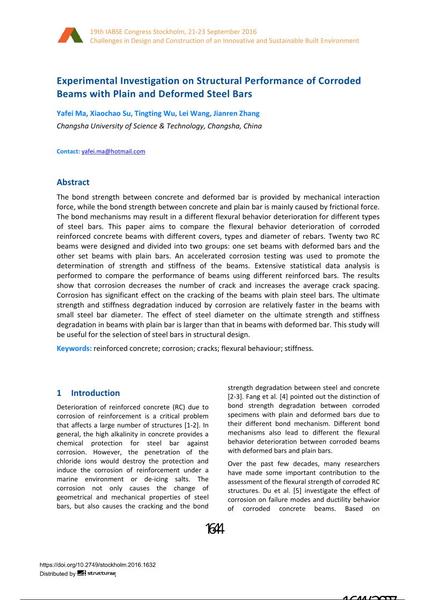Experimental Investigation on Structural Performance of Corroded Beams with Plain and Deformed Steel Bars

|
|
|||||||||||
Bibliographic Details
| Author(s): |
Yafei Ma
(Changsha University of Science & Technology, Changsha, China)
Xiaochao Su (Changsha University of Science & Technology, Changsha, China) Tingting Wu (Changsha University of Science & Technology, Changsha, China) Lei Wang (Changsha University of Science & Technology, Changsha, China) Jianren Zhang (Changsha University of Science & Technology, Changsha, China) |
||||
|---|---|---|---|---|---|
| Medium: | conference paper | ||||
| Language(s): | English | ||||
| Conference: | IABSE Congress: Challenges in Design and Construction of an Innovative and Sustainable Built Environment, Stockholm, Sweden, 21-23 September 2016 | ||||
| Published in: | IABSE Congress Stockholm, 2016 | ||||
|
|||||
| Page(s): | 1644-1651 | ||||
| Total no. of pages: | 8 | ||||
| Year: | 2016 | ||||
| DOI: | 10.2749/stockholm.2016.1632 | ||||
| Abstract: |
The bond strength between concrete and deformed bar is provided by mechanical interaction force, while the bond strength between concrete and plain bar is mainly caused by frictional force. The bond mechanisms may result in a different flexural behavior deterioration for different types of steel bars. This paper aims to compare the flexural behavior deterioration of corroded reinforced concrete beams with different covers, types and diameter of rebars. Twenty two RC beams were designed and divided into two groups: one set beams with deformed bars and the other set beams with plain bars. An accelerated corrosion testing was used to promote the determination of strength and stiffness of the beams. Extensive statistical data analysis is performed to compare the performance of beams using different reinforced bars. The results show that corrosion decreases the number of crack and increases the average crack spacing. Corrosion has significant effect on the cracking of the beams with plain steel bars. The ultimate strength and stiffness degradation induced by corrosion are relatively faster in the beams with small steel bar diameter. The effect of steel diameter on the ultimate strength and stiffness degradation in beams with plain bar is larger than that in beams with deformed bar. This study will be useful for the selection of steel bars in structural design. |
||||
| Keywords: |
corrosion reinforced concrete stiffness flexural behaviour cracks
|
||||
